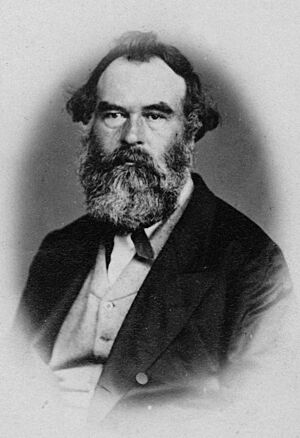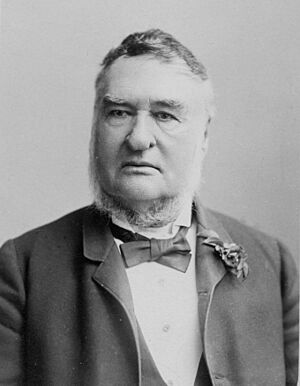B. T. Finniss facts for kids
Quick facts for kids
B. T. Finniss
|
|
|---|---|

Finniss, c. 1860
|
|
| Administrator of South Australia | |
| In office 20 December 1854 – 8 June 1855 |
|
| Preceded by | Sir Henry Young as Governor |
| Succeeded by | R.G. MacDonnell as Governor |
| 1st Premier of South Australia | |
| In office 24 October 1856 – 20 August 1857 |
|
| Monarch | Victoria |
| Governor | Sir Richard MacDonnell |
| Succeeded by | John Baker |
| Chief Secretary of South Australia | |
| In office 28 January 1852 – 24 October 1856 |
|
| Preceded by | Charles Sturt |
| Succeeded by | Office of Premier established |
| In office 14 May 1849 – 25 August 1849 |
|
| Preceded by | Alfred Mundy |
| Succeeded by | Charles Sturt |
| Treasurer of South Australia | |
| In office 12 June 1858 – 9 May 1860 |
|
| Premier | Sir Richard Hanson |
| Preceded by | John Hart |
| Succeeded by | Thomas Reynolds |
| In office 28 April 1847 – 3 January 1852 |
|
| Preceded by | Charles Sturt |
| Succeeded by | Sir Robert Torrens |
| Member of the South Australian House of Assembly |
|
| In office 9 March 1857 – 23 November 1862 |
|
| Preceded by | Seat established |
| Succeeded by | Allan McFarlane |
| Constituency | City of Adelaide (1857–1860) Mount Barker (1860–1862) |
| Member of the South Australian Legislative Council |
|
| In office 1 May 1847 – 8 March 1857 |
|
| Commissioner of the South Australian Police |
|
| In office 13 April 1843 – 12 May 1847 |
|
| Preceded by | Thomas O'Halloran |
| Succeeded by | Captain Dashwood |
| Deputy Surveyor-General of South Australia |
|
| In office 24 August 1839 – April 1843 |
|
| Succeeded by | Thomas Burr the two served together from 1839 |
| Personal details | |
| Born |
Boyle Travers Finniss
18 August 1807 Off the Cape of Good Hope, Africa |
| Died | 24 December 1893 (aged 86) Kensington Park, South Australia |
| Resting place | West Terrace Cemetery |
| Nationality | British |
| Spouses | Anne Rogerson (d.1858) Sophia Lynch |
| Military service | |
| Allegiance | |
| Branch/service | British Army |
| Years of service | 1825–1835 |
| Rank | Lieutenant |
| Unit | 88th Regiment 56th Regiment 82nd Regiment |
Boyle Travers Finniss (born August 18, 1807 – died December 24, 1893) was an important figure in the early history of South Australia. He holds the special title of being the very first premier (or leader of the government) for South Australia. He served in this role from October 24, 1856, to August 20, 1857.
Contents
Early Life and Military Career
Boyle Travers Finniss was born at sea near the Cape of Good Hope in Southern Africa. He spent some of his childhood in Madras, which was then part of British India. For his education, he went to Greenwich, England.
He later joined the Royal Military College, Sandhurst, a famous military school. In 1825, he became an ensign in the British Army. He was promoted to lieutenant in 1827. Finniss spent three years working on roads and bridges in Mauritius.
Becoming a Surveyor in South Australia
In 1835, Finniss left the army. He was then chosen to be an assistant surveyor under Colonel William Light. Light was the Surveyor-General for the new colony of South Australia. Finniss arrived in South Australia in September 1836.
He strongly supported Light's choice for the location of the city of Adelaide. Finniss also helped to plan and lay out the city's streets. During these early years, his letters show he was a thoughtful and capable assistant.
Finniss later joined Light in a private surveying company. They surveyed several towns, including Glenelg and Gawler. After some business challenges, Finniss returned to public service.
Public Service and Political Journey
In 1839, Finniss became the Deputy Surveyor-General. He then took on other important roles. In 1843, he was made Commissioner of the South Australia Police. He also served as a police magistrate.
By 1847, he became the Treasurer of South Australia. This meant he was in charge of the colony's money. In 1851, the governor, Sir Henry Young, chose him to be part of the South Australian Legislative Council. This was an important governing body.
In 1852, Finniss became the Colonial Secretary of South Australia. This was a very senior government position. He helped create a new law in 1853 for a two-chamber parliament in South Australia.
Between December 1854 and June 1855, Finniss acted as the leader of the colony. This was when Governor Young had left and before the new governor, Sir Richard Graves McDonnell, arrived. The 1853 law was changed, and a new one was passed in 1856. This new law allowed for two elected houses of parliament.
Finniss was elected to the new parliament, representing the city of Adelaide. He then made history by becoming South Australia's first Premier and Chief Secretary of South Australia. During his time as premier, he helped pass laws for Adelaide's water supply. He also started the first railway in South Australia.
From 1858 to 1860, he served as Treasurer again. In the 1860 election, he was elected to represent the electoral district of Mount Barker.
Expedition to the Northern Territory (1864)
In 1864, the South Australian government wanted to explore and settle the Northern Territory. They chose Finniss to lead a survey party. He was appointed the Government Resident of the Northern Territory. His job was to explore the Adelaide River and the nearby coastline.
Finniss chose a place called Escape Cliffs for a new settlement. However, his choice was not popular with everyone. The expedition faced many difficulties, including challenges with supplies and interactions with local people. These issues led to Finniss being called back to South Australia in May 1865.
He later appeared before a special government committee in 1866. He defended his actions during the expedition.
Other Interests and Later Life
Finniss was also involved in business. He was on the board of the Duryea Mining Company. He was the chairman of directors from 1862.
He also had an interest in music and writing. In 1860, he published a patriotic song called The Gathering: A War Song of Australia. He also wrote a love song.
In his later years, Finniss continued to serve the public. In 1875, he was part of the forest board. The next year, he worked as the acting auditor general. He retired from government service in 1881.
He spent his free time writing a book about the history of South Australia's government. This book, Constitutional History of South Australia, was published in 1886. Finniss passed away on December 24, 1893, at the age of 86. He is buried at the West Terrace Cemetery.
Family Life
Finniss was married twice. He had a son and two daughters. His first wife was Anne Frances Rogerson. She passed away in 1858. He later married Sophia Florence Maud Lynch in 1878.
His eldest daughter, Fanny Lipson Finniss, was a very special person. She was the first European girl born in South Australia. She was born on December 31, 1836, or January 1, 1837.
Legacy and Namesakes
Many places in Australia are named after Boyle Travers Finniss. This helps remember his important contributions.
- The Finniss River in South Australia.
- The Finniss River in the Northern Territory.
- Finniss Springs in the Northern Territory.
- The South Australian Electoral district of Finniss.
Finniss Street in North Adelaide was named around 1840. It was chosen by a committee to honor important people in Adelaide's founding. Boyle Street and Finniss Street in the Adelaide suburbs of Marion and Oaklands Park were named around 1856.
In 1940, a town called Queen's Own Town, about 60km south of Adelaide, was renamed Finniss.



